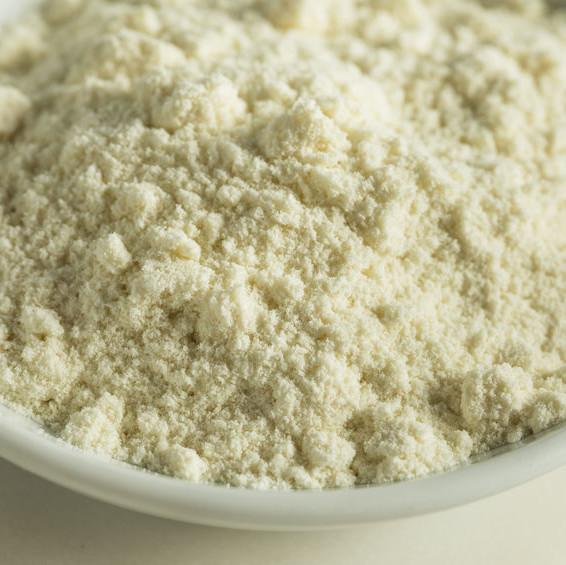Whey Protein
What is Whey Protein?
Whey protein is the protein concentrate or isolates of whey—a liquid left after the straining of coagulated milk curd.1
In baking, whey protein is used for its emulsifying, foaming, gelling, stabilizing, browning, and nutritional properties.1 It is also used as a substitute for egg whites.
Types of whey proteins:
- Whey Protein Concentrate (WPC): contains 34%, 60% and 80% protein and is the most economical type.
- Whey Protein Isolate (WPI): highest protein content (up to 90%).
- Whey Protein Hydrolysate: for infant formulas and medical products.
Origin
Whey protein is a by-product from the cheese industry. It was considered a waste stream up until 1908, when spray dried whey powder was developed.1
In the 1970s, membrane filtration technology opened a new market possibility for manufacturing a high protein powder from whey with a variety of functional properties due to mild processing conditions.1
Function
Whey protein serves several functions in baked goods:2
- Emulsification: aids in stabilization of emulsions, and reducing agglomeration of fat globules.
- Color and flavor development: provides substrate for browning Maillard reaction.
- Whipping: aids in foam stability and volume. It can be used as an egg substitute.
- Water binding: retains water and thus aids in retarding staling.
- Texture: improves texture and mouthfeel by creating moist baked products.
- Improves machinability
- Gelling and thickening
- Nutritional value: provides high quality protein to products.
Nutrition
Typical composition (%) for several whey varieties:1
| Whey Variety | Protein | Lactose | Fat | Ash | Moisture |
|---|---|---|---|---|---|
| WPC34 | 34.0 – 36.0 | 48.0 – 52.0 | 3.0 – 4.5 | 6.5 – 8.0 | 3.5 – 4.5 |
| WPC60 | 60.0 – 62.0 | 25.0 – 30.0 | 1.0 – 7.0 | 4.0 – 6.0 | 3.0 – 5.0 |
| WPC80 | 80.0 – 82-0 | 4.0 – 8.0 | 4.0 – 8.0 | 3.0 – 4.0 | 3.5 – 4.5 |
| WPCI | 90.0 – 92.0 | 0.5 – 1.0 | 0.5 – 1.0 | 2.0 – 3.0 | 4.5 |
Whey proteins are recognized as high-quality proteins due to their balance of essential and non-essential amino acids and may have beneficial anti-inflammatory and anti-hypertensive properties.2
Commercial production
Whey protein is commercially produced through the following process:1
- Clarification and separation: whey from cheese manufacturing is clarified and the cheese fines and whey cream are removed from the main stream.
- Pasteurization: whey is pasteurized at 72 oC (162 oF) for at least 15 seconds.2
- Ultrafiltration: clarified whey is passed through an ultrafiltration membrane to reduce water content.
- Spray drying: resulting liquid is dried to form whey powder.
- Storage: whey protein concentrates should be stored in a cool and dry place at temperatures lower than 27oC (81 oF) with relative humidity of <65%.
Application
Some common usage levels of whey proteins and their effects on baked goods include:2
| Baked Goods | Usage Level | Effect |
|---|---|---|
| Bread | 2% WPC34 |
|
| Cake | 2% WPC80 |
|
| Cookies | 2 – 3% of WPC34 or WPC80 |
|
| Pie Crust | 2 – 3% |
|
| Bake Mixes | 2 – 3% |
|
| Bakery Glazes | 2 -3% |
|
Regulations
Whey protein is considered GRAS by the FDA, when meeting established specifications and its addition should be listed on the label of products.3
In the EU, whey protein is authorized for use as a novel food product by the EU Commission Regulation 2018/1632.4
References
- Guo, M, ed. Whey protein production, chemistry, functionality, and applications. John Wiley & Sons, 2019.
- Reference Manual For U.S. Whey And Lactose Products. 1st ed., U.S Dairy Export Council, pp. 1-9.
- Food and Drug Administration (FDA). US Department of Health and Human Services. CFR Code of Federal Regulations Title 21, Part 184 Direct Food Substances Affirmed As Generally Recognized As Safe, https://www.accessdata.fda.gov/scripts/cdrh/cfdocs/cfcfr/CFRSearch.cfm?fr=184.1979c , Accessed 16 May 2021.
- European Commission (EC). Commission Implementing Regulation (EU) 2018/1632 Of 30 October 2018 Authorising The Placing On The Market Of Bovine Milk Basic Whey Protein Isolate As A Novel Food Under Regulation (EU) 2015/2283 Of The European Parliament And Of The Council And Amending Commission Implementing Regulation (EU) 2017/2470.


